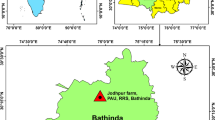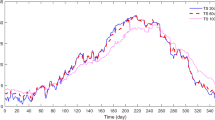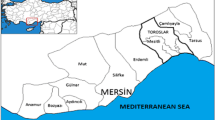Abstract
The objective of this study is to develop data-driven models, including multilayer perceptron (MLP) and adaptive neuro–fuzzy inference system (ANFIS), for estimating daily soil temperature at Champaign and Springfield stations in Illinois. The best input combinations (one, two, and three inputs) can be identified using MLP. The ANFIS is used to estimate daily soil temperature using the best input combinations (one, two, and three inputs). From the performance evaluation and scatter diagrams of MLP and ANFIS models, MLP 3 produces the best results for both stations at different depths (10 and 20 cm), and ANFIS 3 produces the best results for both stations at two different depths except for Champaign station at the 20 cm depth. Results of MLP are better than those of ANFIS for both stations at different depths. The MLP-based spatial distribution is used to estimate daily soil temperature using the best input combinations (one, two, and three inputs) at different depths below the ground. The MLP-based spatial distribution estimates daily soil temperature with high accuracy, but the results of MLP and ANFIS are better than those of the MLP-based spatial distribution for both stations at different depths. Data-driven models can estimate daily soil temperature successfully in this study.











Similar content being viewed by others
References
Adeli H, Hung SL (1995) Machine learning neural networks, genetic algorithms, and fuzzy systems. Wiley, New York
Allen RG, Pereira LS, Raes D, Smith M. (1998) Crop evapotranspiration guidelines for computing crop water requirements. FAO Irrigation and Drainage. Paper No. 56. Food and Agriculture Organization of the United Nations, Rome
Bilgili M (2010) Prediction of soil temperature using regression and artificial neural network models. Meteorol Atmos Phys 110(1–2):59–70
Coulibaly P, Anctil F, Aravena R, Bobee B (2001) Artificial neural network modeling of water table depth fluctuations. Water Resour Res 37(4):885–896
Fletcher R, Reeves CM (1964) Function minimization by conjugate gradients. Comput J 7:149–153
George RK (2001) Prediction of soil temperature by using artificial neural networks algorithms. Nonlinear Anal 47(3):1737–1748
Gupta HV, Kling H, Yilmaz KK, Martinez GF (2009) Decomposition of the mean squared error and NSE performance criteria: Implications for improving hydrological modeling. J Hydrol 377(1–2):80–91
Haykin S (2009) Neural networks and learning machines, 3rd edn. Prentice-Hall, Upper Saddle River, NJ
Hu Q, Feng S (2003) A daily soil temperature dataset and soil temperature climatology of the contiguous United States. J Appl Meteorol 42(8):1139–1156
Jackson T, Mansfield K, Saafi M, Colman T, Romine P (2008) Measuring soil temperature and moisture using wireless MEMS sensors. Measurement 41:381–390
Jain SK, Nayak PC, Sudheer KP (2008) Models for estimating evapotranspiration using artificial neural networks, and their physical interpretation. Hydrol Process 22:2225–2234
Jang JSR (1993) ANFIS: adaptive-network-based fuzzy inference system. IEEE Trans Syst Manag Cyber 23(3):665–685
Jang JSR, Sun CT, Mizutani E (1997) Neurofuzzy and soft computing: a computational approach to learning and machine intelligence. Prentice-Hall, Upper Saddle River, NJ
Karnieli A, Agam N, Pinker RT, Anderson MC, Mark L, Imhoff ML, Gutman GG, Panov N, Goldberg A (2009) Use of NDVI and land surface temperature for drought assessment: merits and limitations. J Clim 23(3):618–633
Kim S, Shiri J, Kisi O (2012) Pan evaporation modeling using neural computing approach for different climatic zones. Water Resour Manag 26(11):3231–3249
Kim S, Shiri J, Kisi O, Singh VP (2013) Estimating daily pan evaporation using different data-driven methods and lag-time patterns. Water Resour Manag 27(7):2267–2286
Kisi O, Shiri J (2013) Prediction of long-term monthly air temperature using geographical inputs. Int J Climatol. doi:10.1002/joc.3676
Kisi O, Kim S, Shiri J (2013) Estimation of dew point temperature using neuro-fuzzy and neural network techniques. Theor Appl Climatol 114(3–4):365–373
Mamdani EH, Assilian S (1975) An experiment in linguistic synthesis with a fuzzy logic controller. Int J Man Mach Stud 7(1):1–13
Mihalakakou G (2002) On estimating soil surface temperature profiles. Energy Build 34(3):251–259
Ozturk M, Salman O, Koc M (2011) Artificial neural network model for estimating the soil temperature. Can J Soil Sci 91(4):551–562
Paul KI, Polglase PJ, Smethurst PJ, O'Connell AM, Carlyle CJ, Khanna PK (2004) Soil temperature under forests: a simple model for predicting soil temperature under a range of forest types. Agric For Meteorol 121:167–182
Simpson PK (1990) Artificial neural systems: foundations, paradigms, applications and implementations. Pergamon, New York
Sudheer KP, Gosain AK, Rangan DM, Saheb SM (2002) Modeling evaporation using an artificial neural network algorithm. Hydrol Process 16:3189–3202
Sudheer KP, Gosain AK, Ramasastri KS (2003) Estimating actual evapotranspiration from limited climatic data using neural computing technique. ASCE J Irrig Drain Eng 129(3):214–218
Tabari H, Sabziparvar AA, Ahmadi M (2011) Comparison of artificial neural network and multivariate linear regression methods for estimation of daily soil temperature in an arid region. Meteorol Atmos Phys 110(3–4):135–142
Takagi T, Sugeno M (1985) Fuzzy identification of systems and its application to modeling and control. IEEE Trans Syst Man Cybern 15(1):116–132
Tsoukalas LH, Uhrig RE (1997) Fuzzy and neural approaches in engineering. Wiley, New York
Van Bavel CHM (1956) Estimating soil moisture conditions and time for irrigation with the evapotranspiration method. USDA, ARS 41–11, U.S. Dept. of Agric., Raleigh, NC, 1–16.
Wasserman PD (1993) Advanced methods in neural computing. Van Nostrand Reinhold, New York
Water and Atmospheric Resources Monitoring Program (2011) Illinois Climate Network, Illinois State Water Survey, 2204 Griffith Drive. Champaign, IL, pp 61820–67495
Wu W, Tang XP, Guo NJ, Yang C, Liu HB, Shang YF (2013) Spatiotemporal modeling of monthly soil temperature using artificial neural networks. Theor Appl Climatol 113(3–4):481–494
Yang CC, Prasher SO, Mehuys GR (1997) An artificial neural network model to estimate soil temperature. Can J Soil Sci 77(3):421–429
Yilmaz T, Ozbek A, Yilmaz A, Büyükalaca O (2009) Influence of upper layer properties on the ground temperature distribution. J Therm Sci Technol 29(2):43–51
Zheng D, Raymond Hunt E Jr, Running SW (1993) A daily soil temperature model based on air temperature and precipitation for continental applications. Climate Res 2:183–191
Author information
Authors and Affiliations
Corresponding author
Rights and permissions
About this article
Cite this article
Kim, S., Singh, V.P. Modeling daily soil temperature using data-driven models and spatial distribution. Theor Appl Climatol 118, 465–479 (2014). https://doi.org/10.1007/s00704-013-1065-z
Received:
Accepted:
Published:
Issue Date:
DOI: https://doi.org/10.1007/s00704-013-1065-z




